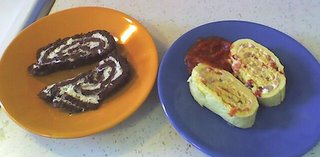dance skills reflect attractiveness
OK, this is a cool study. Some researchers at Rutgers and the U. of Washington wanted to look at whether dance skills are correlated with attractiveness. This is a pretty interesting question in biology. In recent years, researchers have started to figure out what makes individuals attractive to other individuals. You may remember some well-publicized work about 10 years ago that showed that when you average a bunch of faces together, the resulting average is more attractive than most of the underlying faces. This turns out to be due to something with the unfortunate name "fluctuating asymmetry." Oy. Basically what that turns out to mean is the extent to which an organism has variations from biateral symmetry. In this study, they measured the sizes of "the elbow, wrist, knee, ankle, foot, third digit, fourth digit, fifth digit and ears," then came up with a metric for how much differences there are between left and right. It's believed that genetic defects, malnutrition, etc. are reflected in asymmetry, so the more symmetrical you are, the healthier you seem. And it's been shown that animals and people pick up on asymmetry, and rate symmetrical animals/people more attractive.
This new study wonders whether dance skill (which birds, bees, and people all have in varying amounts) also correlates with symmetry and attractiveness. "In species where fathers invest less than do mothers in their offspring, females are expected to be more selective in mate choice, and males to invest more in courtship display. Thus, we predicted that degree of symmetry would more strongly correlate with male dance ability, and females would be better discriminators."
The researchers got a set of young Jamaicans to dance to some pop music with
 ping-pong balls attached all over their bodies. Using the same basic technique that Andy Serkis used in the Lord of the Rings movies to give motion to the computer-animated Gollum, the researchers captured the motion of the ping-pong balls and used that motion to make a stick figure dance. This was done to get rid of all the identifying characteristics of the dancers. In fact, when the subjects then evaluated the dancing stick figures, they were only a little better than chance (62%) at guessing the gender of the dancer.
ping-pong balls attached all over their bodies. Using the same basic technique that Andy Serkis used in the Lord of the Rings movies to give motion to the computer-animated Gollum, the researchers captured the motion of the ping-pong balls and used that motion to make a stick figure dance. This was done to get rid of all the identifying characteristics of the dancers. In fact, when the subjects then evaluated the dancing stick figures, they were only a little better than chance (62%) at guessing the gender of the dancer.Then they had the same group of people evaluate the quality of the dancing on a scale from 0 to 100. They were able to break down the answers by the gender of the evaluator and the dancer, and by the symmetry of the evaluator and the dancer. Here are their main results:
For male dancers, symmetry was strongly correlated with how well they were thought to dance. In fact, symmetry accounts for half of the male dancers' dance skill. For female dancers, the correlation was much weaker, with only a quarter of the dance skill correlated with symmetry. The fact that this is true at all is quite remarkable! Does this mean that symmetrical (and thus attractive) people are inherently better dancers? Or that, because of their attractiveness, they find dancing more rewarding (because they get more attention) and thus get more practice at it?
They also found that female evaluators reported a wider range of skills in the dances they evaluated, and in particular that the difference between their high ratings and low ratings of male dancers were particularly large. That is, women know good dancing when they see it.
For the record, I would be in the "two left feet subgroup", uniformly laughed at by female evaluators...










